Instructions for Side by Side Printing
- Print the notecards
- Fold each page in half along the solid vertical line
- Cut out the notecards by cutting along each horizontal dotted line
- Optional: Glue, tape or staple the ends of each notecard together
A&P Chapter 14 The Autonomic Nervous System
front 1 Drag the appropriate labels to their respective targets. | back 1 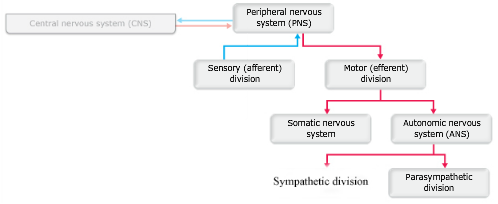 |
front 2 Drag the appropriate labels to their respective targets. | back 2 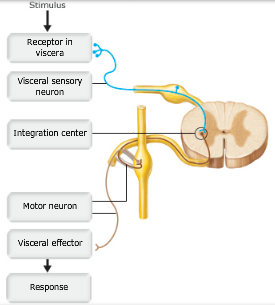 |
front 3 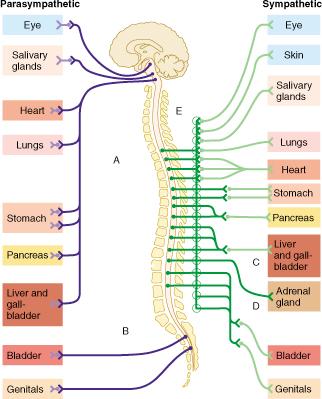 Outflow of the sympathetic division occurs from which regions of the CNS? | back 3 thoracic and lumbar |
front 4 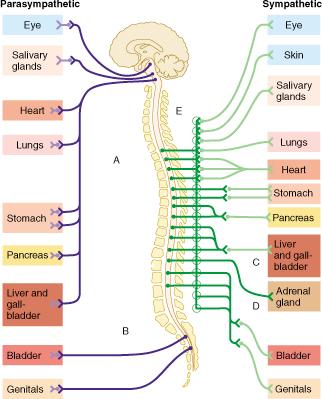 Which organ receives major input from the sympathetic, but not parasympathetic, division? | back 4 skin |
front 5 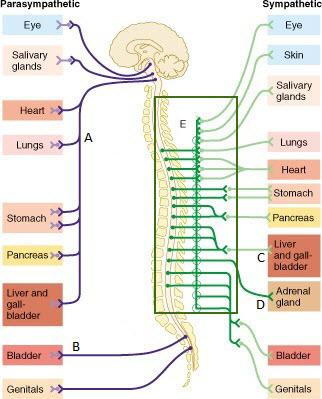 The group of fibers indicated by E represents which of the following? | back 5 white rami communicantes |
front 6 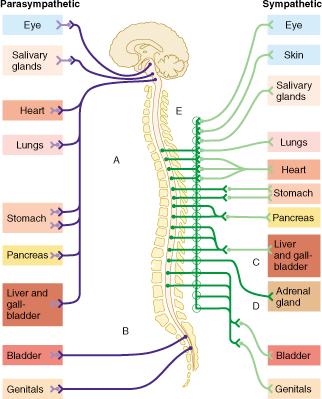 Which of the following statements is true of the group of fibers indicated by the letter D? | back 6 D indicates fibers which bypass collateral ganglia and terminate within the adrenal gland. |
front 7  Neurons that control the voluntary movement of the arm would be associated with which pathway? | back 7 A only |
front 8 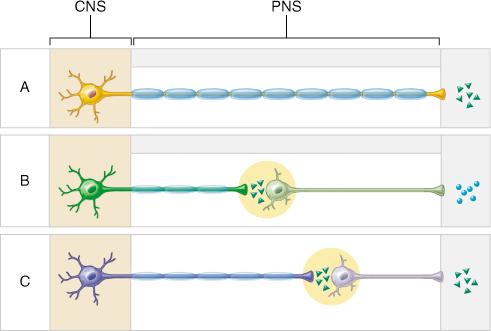 The circular structures shown within both pathways B and C represent which of the following? | back 8 ganglia |
front 9 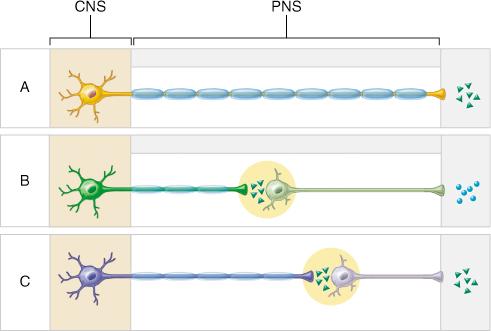 Which of the following is the site of the release of the neurotransmitter norepinephrine? | back 9 terminus of a sympathetic postganglionic neuron |
front 10 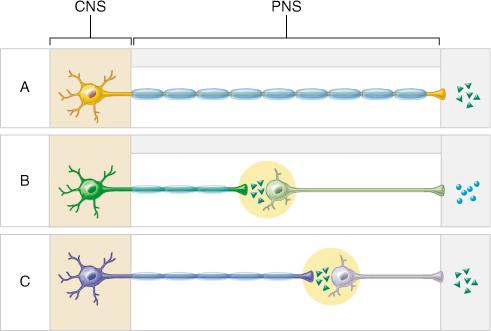 Which of the following statements is true? | back 10 The effects of neurotransmitters released from either sympathetic or parasympathetic postganglionic neurons may be stimulatory or inhibitory. |
front 11 Which of the following is a way in which the somatic and autonomic nervous systems are similar? Both systems elicit the same target organ responses to their
neurotransmitters. | back 11 None of the above. |
front 12 Which of the following is not a result of parasympathetic stimulation? | back 12 dilation of the pupils |
front 13 Because the ANS is a visceral motor system, afferent pathways are of no importance and actually are rarely found. | back 13 False |
front 14 The ANS contains both sensory and motor neurons.. | back 14 False |
front 15 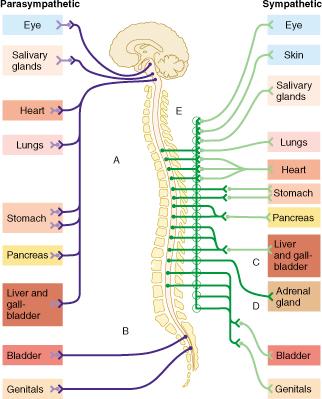 Which component of the ANS is characterized by ganglia located in or near effector organs? | back 15 parasympathetic division |
front 16 Oculomotor nerves are responsible for which of the following functions? | back 16 focusing the eyes on close objects |
front 17 Parasympathetic ganglia are also called __________ because of their location. | back 17 terminal ganglia |
front 18 The secretions of the adrenal medulla act to supplement the effects of ________. | back 18 sympathetic stimulation |
front 19 The parasympathetic ganglion that serves the eye is the ________. | back 19 ciliary ganglion |
front 20 Sympathetic nerves may leave the spinal cord at which vertebra? | back 20 first thoracic |
front 21 Which of the following is NOT an autonomic nervous system (ANS) effector? | back 21 skeletal muscle |
front 22 Conduction through the autonomic efferent chain is faster than conduction in the somatic motor system. | back 22 False |
front 23 The ANS stimulates smooth muscles, skeletal muscles and glands, whereas the somatic nervous system innervates skeletal muscles only. | back 23 False |
front 24 Which of these effectors is not directly controlled by the autonomic nervous system? | back 24 skeletal muscle |
front 25 Preparing the body for the "fight-or-flight" response is the role of the ________. | back 25 sympathetic nervous system |
front 26 Which of the following is responsible for the overall integration of the autonomic nervous system (ANS)? | back 26 hypothalamus |
front 27 All visceral organs receive dual innervation from both the sympathetic and parasympathetic divisions of the ANS. | back 27 False |
front 28 Norepinephrine-releasing fibers are called cholinergic fibers. | back 28 False |
front 29 For which of the following activities is the parasympathetic nervous system generally responsible? | back 29 resting and digesting |
front 30 Thermoregulatory responses to increased heat are mediated by the sympathetic nervous division. | back 30 True |
front 31 Through direct neural stimulation, the sympathetic division promotes many metabolic effects via hormone release. | back 31 True |
front 32 The two types of receptors that bind acetylcholine are __________ and __________ receptors. | back 32 nicotinic; muscarinic |
front 33 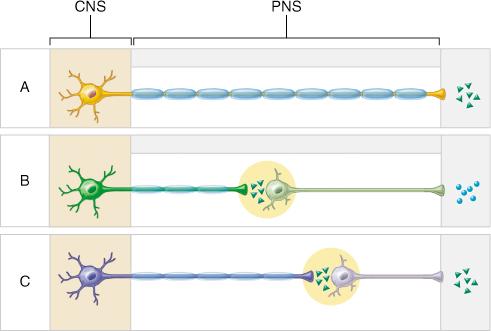 Which pathways comprise the autonomic nervous system? | back 33 B and C |
front 34 Which of the following is responsible for the overall integration of the autonomic nervous system (ANS)? | back 34 hypothalamus |
front 35 What differentiates an autonomic reflex from a somatic reflex? | back 35 a two-neuron motor pathway |
front 36 Beta-blockers ________. | back 36 decrease heart rate and blood pressure |
front 37 Which autonomic neurons release norepinephrine as a neurotransmitter? | back 37 sympathetic postganglionic neurons |
front 38 The sympathetic division is also called the "thoracolumbar division" of the autonomic nervous system. | back 38 True |
front 39 Cardiovascular effects of the sympathetic division include all except ________. | back 39 dilation of the blood vessels serving the skin and digestive viscera |
front 40 The two divisions of the autonomic nervous system (ANS) normally have a(n) __________ relationship. | back 40 antagonistic |
front 41 Because many of the same cardiac cells are innervated by both parasympathetic and sympathetic fibers, the influence of the two divisions on the heart is synergistic. | back 41 False |
front 42 The autonomic nervous system may cause activation or inhibition, depending on the division that is active and the target that is affected. | back 42 True |
front 43 The craniosacral division is another name for the parasympathetic division. | back 43 True |
front 44 Autonomic reflex centers occur in the spinal cord, medulla, and midbrain. | back 44 True |
front 45 Which of the following does not describe the ANS? | back 45 a system of motor neurons that innervates all muscle cells |
front 46 The sympathetic division is also called the "thoracolumbar division" of the autonomic nervous system. | back 46 True |
front 47 Because many of the same cardiac cells are innervated by both parasympathetic and sympathetic fibers, the influence of the two divisions on the heart is synergistic. | back 47 False |
front 48 Emotions influence autonomic reactions primarily through integration in the ________. | back 48 hypothalamus |
front 49 Which of the following is NOT an autonomic nervous system (ANS) effector? | back 49 skeletal muscle |
front 50 Which autonomic neurons release norepinephrine as a neurotransmitter? | back 50 sympathetic postganglionic neurons |
front 51 The "resting and digesting" division of the autonomic nervous system is the ________. | back 51 parasympathetic division |
front 52 Thermoregulatory responses to increased heat are mediated by the sympathetic nervous division. | back 52 True |
front 53 All visceral organs receive dual innervation from both the sympathetic and parasympathetic divisions of the ANS. | back 53 False |
front 54 Cardiovascular effects of the sympathetic division include all except ________. | back 54 dilation of the blood vessels serving the skin and digestive viscera |
front 55 Which division of the nervous system has short preganglionic neurons? | back 55 sympathetic |
front 56 Acetylcholine is the substance released by the axonal endings of the somatic efferent fibers and by the parasympathetic nerve fiber endings. | back 56 True |
front 57 Which of the following is NOT associated with the parasympathetic division of the autonomic nervous system (ANS)? | back 57 emergency action |
front 58 Conduction through the autonomic efferent chain is faster than conduction in the somatic motor system. | back 58 False |
front 59 The sympathetic and parasympathetic divisions of the ANS have the same effect on most body organ systems. | back 59 False |
front 60 Norepinephrine-releasing fibers are called cholinergic fibers. | back 60 False |
front 61 The ANS stimulates smooth muscles, skeletal muscles and glands, whereas the somatic nervous system innervates skeletal muscles only. | back 61 False |
front 62 For which of the following activities is the parasympathetic nervous system generally responsible? | back 62 resting and digesting |
front 63 Autonomic reflex centers occur in the spinal cord, medulla, and midbrain. | back 63 True |
front 64 Preparing the body for the "fight-or-flight" response is the role of the ________. | back 64 sympathetic nervous system |
front 65 Which of the following is responsible for the overall integration of the autonomic nervous system (ANS)? | back 65 hypothalamus |
front 66 Which of these effectors is not directly controlled by the autonomic nervous system? | back 66 skeletal muscle |
front 67 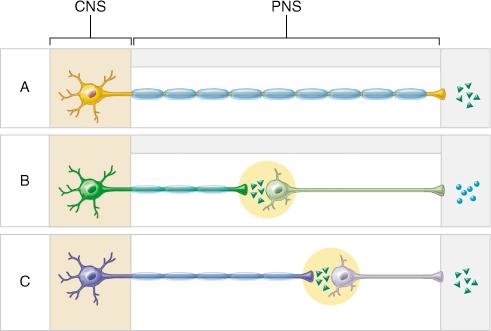 Which pathways comprise the autonomic nervous system? | back 67 B and C |
front 68 What is the effect of norepinephrine on the heart? | back 68 an increase in heart rate |
front 69 Which of the following does not describe the ANS? | back 69 a system of motor neurons that innervates all muscle cells |
front 70 Through direct neural stimulation, the sympathetic division promotes many metabolic effects via hormone release. | back 70 True |